PCIe SSD Faceoff: Samsung XP941 (128GB & 256GB) and OCZ RevoDrive 350 (480GB) Tested
by Kristian Vättö on September 5, 2014 3:00 PM ESTRandom Read/Write Speed
The four corners of SSD performance are as follows: random read, random write, sequential read and sequential write speed. Random accesses are generally small in size, while sequential accesses tend to be larger and thus we have the four Iometer tests we use in all of our reviews.
Our first test writes 4KB in a completely random pattern over an 8GB space of the drive to simulate the sort of random access that you'd see on an OS drive (even this is more stressful than a normal desktop user would see). We perform three concurrent IOs and run the test for 3 minutes. The results reported are in average MB/s over the entire time.

Random read performance remains unchanged for the XP941 despite the lower capacity, while the RevoDrive does not really enjoy any performance increase over other SandForce based SSDs.
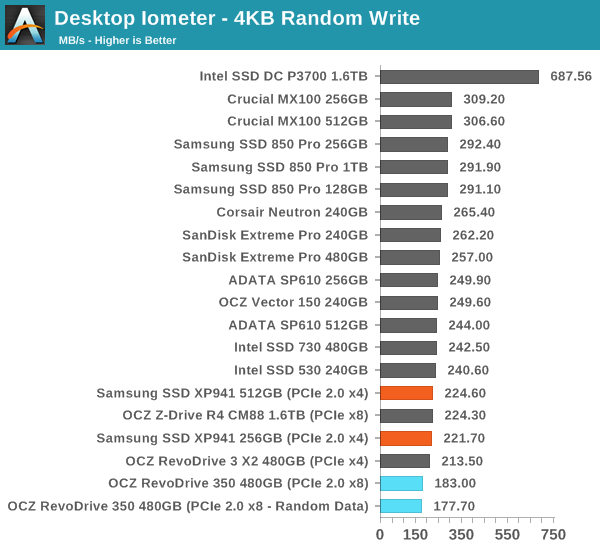
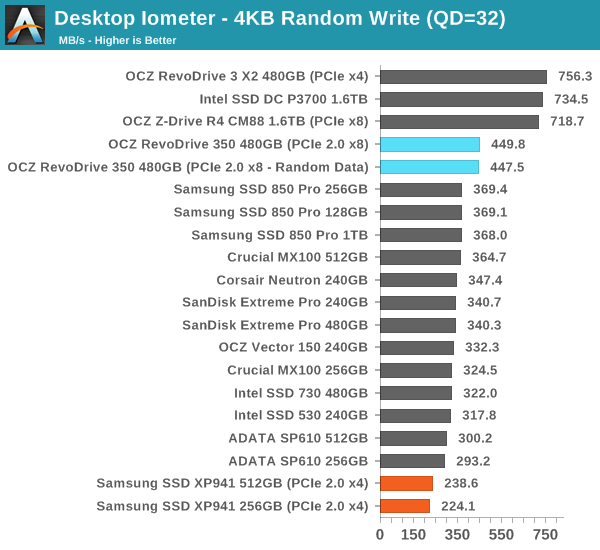
As for random write, the 256GB XP941 appears to be almost a match for the 512GB. The RevoDrive is a fairly interesting case because at low queue depths its performance is pretty bad, but the performance scales with the queue depth. Again, RAID only helps when there are multiple IOs in parallel, which only happens at high queue depths. At low queue depths RAID only seems to cause overhead, which would explain the low performance.
Sequential Read/Write Speed
To measure sequential performance we run a 1 minute long 128KB sequential test over the entire span of the drive at a queue depth of 1. The results reported are in average MB/s over the entire test length.
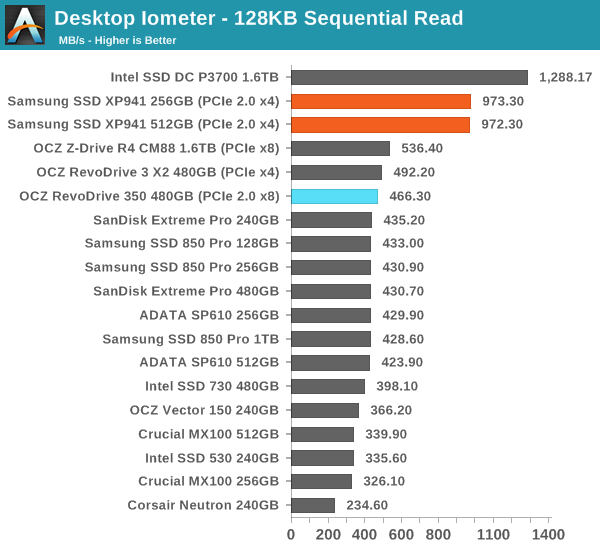
The XP941 continues to be strong, but the RevoDrive still does not offer much benefit over a SATA drive. We are dealing with a QD1 situation here so the RevoDrive cannot really take advantage of its internal parallelism.
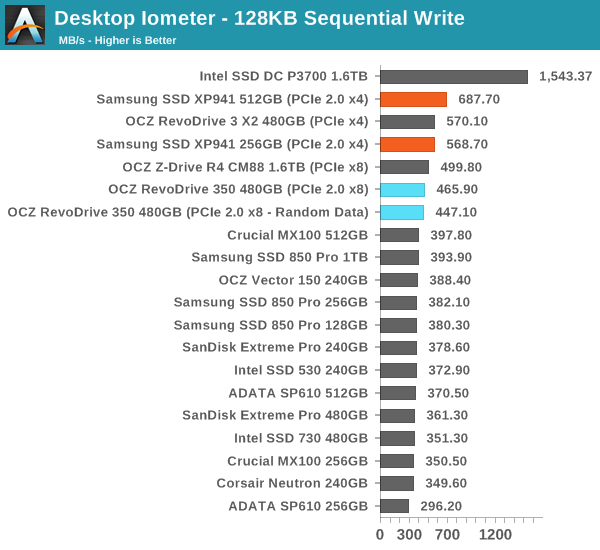
AS-SSD Incompressible Sequential Read/Write Performance
The AS-SSD sequential benchmark uses incompressible data for all of its transfers. The result is a pretty big reduction in sequential write speed on SandForce based controllers, but most other controllers are unaffected.

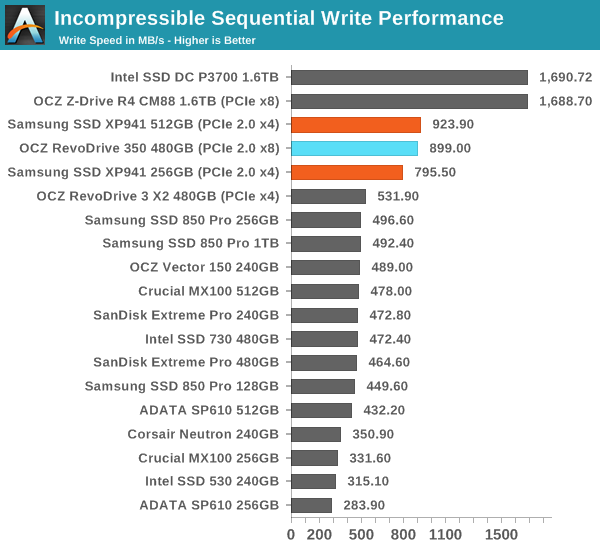










47 Comments
View All Comments
Intervenator - Friday, September 5, 2014 - link
Need MOAR insight into the PCIe SSD market! Wheres it going? Any noticeable performance increased to the end user? Who are the players in the market? Non performance advantages?If AnandTech has already written an article regarding any of this, could someone please point me towards it?
Intervenator - Friday, September 5, 2014 - link
Oh, and great review.Kristian Vättö - Friday, September 5, 2014 - link
We haven't done an article that collects all bits of info into one, but you may find the following articles interesting:http://www.anandtech.com/show/8006/samsung-ssd-xp9...
http://www.anandtech.com/show/7843/testing-sata-ex...
http://www.anandtech.com/show/7520/lsi-announces-s...
http://www.anandtech.com/show/8147/the-intel-ssd-d...
http://www.anandtech.com/show/8104/intel-ssd-dc-p3...
frenchy_2001 - Friday, September 5, 2014 - link
>Where is it going?M.2 form factor using PCIe gen3 x4 for portable and consumer, PCIe cards, up to Gen3 x8 for Datacenter/server. Both running NVMe protocol.
I don't see much future for SATAexpress, as the 2 other competing standards cover all the use cases already (and better too).
> Any noticeable performance increased to the end user?
Not unless you do a LOT of parallel IOs. For consumer, there is a diminutive return past the original boost from switching to SSD (mostly from lower latencies). HDD to SATA SSD gave orders of magnitude improvements. SATA3 -> PCIe is only incremental compared to that. Unless you need this for a server, video processing or other big IO limited task, there will be little difference.
>Who are the players in the market?
Still the same: Intel/Micron/Samsung/Sandisk for professionals/servers using mostly in-house designs (intel P3700 for example).
Marvel and Sandforce have announced PCIe NVMe controllers. No products for those yet.
>Non performance advantages?
M.2 will be more compact. Power draw should be more optimized. NVMe should have lower processor overhead.
Impulses - Friday, September 5, 2014 - link
Thx for that.iwod - Saturday, September 6, 2014 - link
Since speed is a relative thing. The HDD to SSD leap were amazing. But that doesn't mean you cant feel the different between SSD @ SATA 3GBps and SSD@ 6Gbps. And with the recent controller improvement on Random / Seq RW, I can also feel the difference between SATA and NVMe PCIe SSD.But with the increase memory capacity, the time to fetch things SSD will also be lower since they are likely cached. So throughput may become less of a concern after PCIe SSD, and average response time will play a role. Luckily this is already being worked on for server SSD usage. So they will likly filter down once PCIe SSD becomes mainstream.
For the future I would like to see even lower active power consumption. I wonder if they could get it under 2W.
Friendly0Fire - Friday, September 5, 2014 - link
This makes me think that the SM951 with X99 will be one hell of a beast... I want one. Heck, the XP941 would already be amazing.GrigioR - Friday, September 5, 2014 - link
Is it possible to boot from those PCIe drives using a 775 motherboard (p35chipset)? Getting rid of Satall bottleneck would be awesome on my modded Xeon system.Kristian Vättö - Friday, September 5, 2014 - link
The SM951 likely won't be bootable since it is an OEM drive, but there will be retail PCIe SSDs that are bootable even in older systems (the Plextor M6e should be, for instance).GrigioR - Sunday, September 7, 2014 - link
Nice. Too pricey 1$/GB on the 256GB model... Since my motherboard is PCIe 1.0/1.1 it would run at 500MB/s max... That should not be that noticieable. My Samsung 840 120/128GB runs at +- 250-260MB/s (read)... At least if it were a PCIe x4 it would do 1000MB (bus speed). I`ll leave this the way it is for now. Thank you very much for your input. Now i know it is possible.